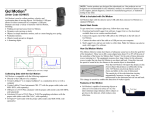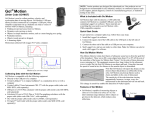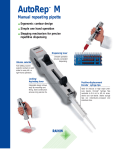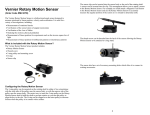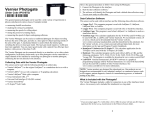Download Vernier Motion Detector
Transcript
Collecting Data with the Motion Detector Motion Detector 2 (Order Code MD-BTD) The Motion Detector is used to collect position, velocity, and acceleration data of moving objects. Students can study a variety of motions with the Motion Detector, including Walking toward and away from the Motion Detector. Dynamics carts moving on track. Objects in simple harmonic motion, such as a mass hanging on a spring. Pendulum motions. Objects dropped or tossed upward. A bouncing object. Motion data collected with Logger Pro® and a computer. The Motion Detector is compatible with the following data-collection interfaces. Vernier LabQuest® 2 or original LabQuest® as a standalone device or with a computer Vernier LabQuest® Mini with a computer Vernier LabPro® with a computer or TI graphing calculator Vernier SensorDAQ® CBL 2™ TI-Nspire™ Lab Cradle Universal Lab Interface (requires separate cable, order code ULI-MDC) Here is the general procedure to follow when using the Motion Detector: 1. Connect the Motion Detector to the interface. 2. Start the data-collection software. 3. The software will identify the Motion Detector and load a default data-collection setup. You are now ready to collect data. What is Included with the Motion Detector? The Motion Detector ships with the detector and a cable that connects the Motion Detector to LabPro, LabQuest 2, LabQuest, LabQuest Mini, TI-Nspire Lab Cradle, or CBL 2. How the Motion Detector Works This Motion Detector emits short bursts of ultrasonic sound waves from the gold foil of the transducer. These waves fill a cone-shaped area about 15 to 20° off the axis of the centerline of the beam. The Motion Detector then “listens” for the echo of these ultrasonic waves returning to it. The equipment measures how long it takes for the ultrasonic waves to make the trip from the Motion Detector to an object and back. Using this time and the speed of sound in air, the distance to the nearest object is determined. Note that the Motion Detector will report the distance to the closest object that produces a sufficiently strong echo. The Motion Detector can pick up objects such as chairs and tables in the cone of ultrasound. Ball Toss with Logger Pro Motion data collected with a calculator. The sensitivity of the echo detection circuitry automatically increases, in steps, every few milliseconds as the ultrasound travels out and back. This is to allow for echoes being weaker from distant objects. Ball bouncing Weight on spring Student walking NOTE: Vernier products are designed for educational use. Our products are not designed nor recommended for any industrial, medical, or commercial process such as life support, patient diagnosis, control of a manufacturing process, or industrial testing of any kind. This sensor is equipped with circuitry that supports auto-ID. When used with LabQuest 2, LabQuest, LabQuest Mini, LabPro, SensorDAQ, TI-Nspire Lab Cradle, or CBL 2, the data-collection software identifies the sensor and uses pre-defined parameters to configure an experiment appropriate to the recognized sensor. 2 Features of the Motion Detector The Motion Detector is capable of measuring objects as close as 0.15 m and as far away as 6 m. The short minimum target distance (new to this version of the Motion Detector) allows objects to get close to the detector, which reduces stray reflections. The Motion Detector has a pivoting head, which helps you aim the sensor accurately. For example, if you wanted to measure the motion of a small toy car on an inclined plane, you can lay the Motion Detector on its back and pivot the Motion Detector head so that it is perpendicular to the plane. The Motion Detector has a Sensitivity Switch, which is located under the pivoting Motion Detector head. To access it, simply rotate the detector head away from the detector body. Rubber feet on the Motion Detector provide stability. Rubber feet are located on the back of the Motion Detector, which provides stability when the Motion Detector is placed on its back. Rubber feet on the bottom provide stability when the Motion Detector is standing up. A standard camera screw mount can be found on the back of the Motion Detector. This screw mount allows you to use the Motion Detector Clamp (sold separately, order code MD-CLAMP), which is a universal-mounting clamp, or to use it with typical tripod-mounting hardware. Camera Screw Mount Motion Detector Clamp (sold separately) Connecting the Motion Detector to an Interface To use the Motion Detector with LabPro, LabQuest 2, LabQuest, LabQuest Mini, TI-Nspire Lab Cradle, or CBL 2, the Motion Detector is connected to the interface with the included cable. Connect the cable to the DIG/SONIC port on the side of the Motion Detector. Connect the other end of the cable to the interface. To use the Motion Detector with the Universal Lab Interface, connect the cable to Port 2 of the ULI. 3 Using the Sensitivity Switch Slide the Sensitivity Switch to the right to set the switch to the “Normal” setting. This setting is best used for experiments such as studying the motion of a person walking back and forth in front of the Motion Detector, a ball being tossed in the air, pendulum motion, and any other motion involving relatively large distances or with objects that are poor reflectors, e.g., coffee filters. The other sensitivity setting, which we call “Track,” works well when studying motion of carts on tracks like the Vernier Dynamics System, or motions in which you want to eliminate stray reflections from objects near to the sensor beam. Using the Motion Detector with Other Sensors The Motion Detector can be used with one or more other sensors connected to the interface. Here are some examples of how the Motion Detector can be used for experiments with another sensor: With a force sensor to study the relationship between force and motion With a force sensor to study collisions and impulse With a force sensor to study simple harmonic motion With a light sensor to study the inverse square law With a magnetic field sensor to study how magnetic field varies with position With a second Motion Detector (LabPro, LabQuest 2, LabQuest, TI-Nspire Lab Cradle, and LabQuest Mini only) Tips on Getting Good Results with the Motion Detector1 The most frequently reported problems with a Motion Detector are (1) that the Motion Detector does not work beyond a certain distance or (2) that the graph is very noisy. There are a number of ways to troubleshoot these situations, and they are described below. 1. See if the Sensitivity Switch makes a difference. Simply set the Sensitivity Switch to the other position and retry the experiment. This change may solve the problem. 2. The Motion Detector does not work beyond a certain distance, e.g., it does not detect anything beyond 1.2 m. Here are some things to check if you have this problem: Check for movable objects (textbooks, ring stands, etc.) in the cone of the ultrasound. If possible, move these objects out of the measurement cone. It may not take a very large object to cause problems. 1 An excellent discussion of motion detector theory and operation can be found in “Physics and Technical Characteristics of Ultrasonic Sonar Systems”, Dan MacIsaac and Ari Hamalainen, The Physics Teacher 40, 39–46 (January 2002). 4 Check for a stationary object (chair, table, etc.) in the cone of the ultrasound. This object may be detected when you are trying to study an object further away. It may not take a very large object to cause problems. If you have trouble with a stationary object causing unwanted echoes, try setting the equipment up so that the objects are not in the cone or placing a cloth over the object. This minimizes the ultrasound reflection. Also note that the cone of ultrasound extends downward from the center line. This can cause problems if you are using the Motion Detector on a hard, horizontal surface. In these cases, try pivoting the head of the Motion Detector to aim it slightly upward. 3. Noisy or erratic data may have a number of causes. Here are some tips. Sometimes other sound sources can cause problems. If there is another source of ultrasonic waves in the same frequency range, this will cause erroneous readings. Examples include motors and fans, air track blowers, the sound made by the air exiting the holes on an air track, etc. Try to eliminate these sources of noise. If you are using an air track, try changing the air flow volume. Make sure that the Motion Detector is not placed close to a computer or computer monitor. If the room in which the Motion Detector is being used has a lot of hard, soundreflecting surfaces, you can get strange effects caused by the ultrasound bouncing around the room. Standing waves can be set up between the Motion Detector and a sound reflector. Try placing a cloth horizontally just in front of and below the Motion Detector. This sometimes helps eliminate ultrasound that is “skipping” into the Motion Detector. Try changing the data-collection rate. Sometimes Motion Detectors work better at one data rate than another. Rates above 30 Hz do not work well in acoustically live rooms. If you are studying people moving, have them hold a large, flat object (e.g., a large book or a pizza box) as a reflector. If you have an irregular reflecting surface, sometimes the waves will be reflected back to the transducer, and sometimes not. The results will seem erratic. Support Products Motion Detector Clamp (order code MD-CLAMP) The Motion Detector Clamp attaches to the back of the Motion Detector, and then the clamp can be attached to a variety of objects such as table tops, ring stands, etc. The clamp adds versatility. Vernier Dynamics System (order code VDS) The Vernier Dynamics System consists of a versatile track and two carts with ultra low friction bearings. This system facilitates performing kinematics and dynamics experiments. The Motion Detector attaches to the dynamics track in such a way that the entire track can be used for motion studies. Warranty Vernier warrants this product to be free from defects in materials and workmanship for a period of five years from the date of shipment to the customer. This warranty does not cover damage to the product caused by abuse or improper use Specifications Range: 0.15 to 6 m Resolution: 1 mm 5 6 Vernier Software & Technology 13979 S.W. Millikan Way Beaverton, OR 97005-2886 Toll Free (888) 837-6437 (503) 277-2299 FAX (503) 277-2440 [email protected] www.vernier.com Rev. 11/8/12 Logger Pro, Logger Lite, Vernier LabQuest 2, Vernier LabQuest, Vernier LabQuest Mini, Vernier LabPro, Go! Link, Vernier EasyLink and other marks shown are our trademarks or registered trademarks in the United States. TI-Nspire, CBL 2 and CBL, TI-GRAPH LINK, and TI Connect are trademarks of Texas Instruments. All other marks not owned by us that appear herein are the property of their respective owners, who may or may not be affiliated with, connected to, or sponsored by us. Printed on recycled paper. 7 8




